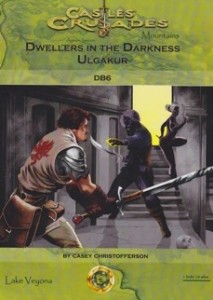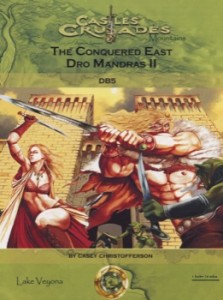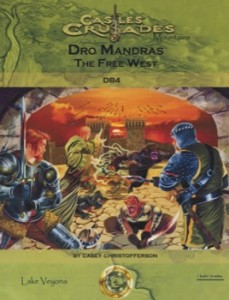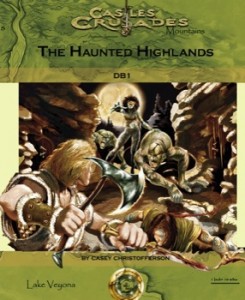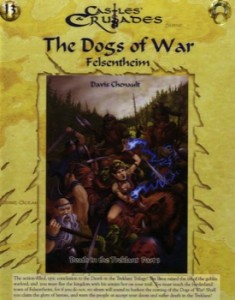This is a Castles & Crusades adventure module, although it can easily be used with and pre-4E version of D&D.
This is a small village area with a couple of cave complex dungeons and a few wilderness encounters. The various areas are a bit disconnected, and presented more as ideas for the DM to use, as opposed to a well-connected series of adventurers.
The various encounter areas in this adventure module are strangely disconnected. We’re presented with a village, several wilderness encounters, and a couple of dungeon complexes. These are strangely disconnected. The wilderness encounters don’t show up on any map, they are presented more in a way that the DM can force the PC’s to stumble across them. I suspect this is more like how many DM’s run their actual games: you go someplace (the village) to get an objective then stumble around the wilderness looking for your goal while meeting various encounters the DM has dreamed up. Finally the DM drops a hint in a wilderness encounter that leads you to the core dungeon. I understand that this is the essence of every town/wilderness/dungeon adventure, however the degree of … vagueness? in the various encounters means that this is essentially a story based adventure until you get to the main dungeon. Or perhaps it’s more like a sandbox or design kit, with many options provided to the DM in order to get the party doing something. In any event, it left me feeling a bit uneasy … even though I’ve railroaded my players many times in the past.
The town of Botkinburg is presented. It really only has a tavern/inn and a manor home. Everyone else is a farmer of some sort or another. About 25 areas in the town and nearby halfling village are described. The townsfolk are not particularly memorable, although they do each have some quirks. I wish there were more subplots going on than just the current crisis. Quite a few of the townsfolk may accompany the party if they try to recruit them. i appreciate that sort of detail in a town description, especially when it’s meant to be a home base. The potential recruits are of varying quality and have various motivations, which is a nice touch. There are some issues with the text in places. For example, a few of the townsfolk visit a witch in the woods. The witch lives 6 days in to the woods. That’s 12 days away from home. SOMEONE is going to notice that. Overall the village is not very impressive; Just Another Fantasy Village With A Problem. In this case, some humanoid raids and some missing/kidnapped children.
The wilderness encounters are more interesting. Rather, taken as a whole they are more interesting. The individual encounters lack atmosphere however when taken together they provide the campaign environment an interesting flair. Ruins in the wilderness. Strange magical animals, witches in the forest … it’s almost a lighter magical game, more realistic, and with the elements of the fantastic grounded in a more fairy-tale element. There’s an elder witch deep in the forest. She’s not necessarily hostile. There’s a giant magical intelligent otter that’s been captured and is being interrogated by bugbears. There’s an ogre living in an abandoned cliffside fort. These and more give the lands an interesting feel, although none of the individual encounters are very atmospheric. One of the encounters is fairly large, a kobold cave complex with an old tomb at the end. The cave is interesting, with ledges, tunnels, and so on. The tomb portion, while small, is interesting as well, with walls to tunnel through and treasure presented in an interesting way. I actually preferred this small complex to the main dungeon, even though it has kobolds and is fairly linear. I should also note the wandering monster table is nicer than average. All of the entries on the table, humanoid and animal, are doing something. “After a raid, encamped” or “searching for new home” or “eating.” I like those sorts of elements. It helps bring a game world to life.
The main dungeon is in two parts, with a single connection between the two. The upper portion is occupied by humanoids while the lower section is more of an unused portion of a military complex from deep in the past. That portion has some treasure and and a nice spooky guardian. The upper portion basically just has humanoids. There’s about 30 keyed locations between the two locations, with most being on the upper portion. With one notable exception, there’s not much going on in the upper portion other than ‘room with goblinoid raiders.’ The lower portion, being abandoned, is more interesting from an exploration standpoint, but is far too small to be a major play area. I wish the upper portion had a more organized response to incursions and there were more weird and fantastic elements in the dungeon.
The village is realistic, which means boring. The wilderness encounters border on the fantastic, which is wonderful, although there is no wilderness map and it must therefore be a bit of DM railroad to get those encounters in to use. The core dungeon is really just a humanoid lair while the supplemental kobold dungeon is more interesting from an exploration standpoint.
This is available on DriveThru.

